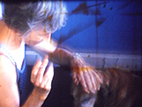Nothing is Over Nothing
- Jonathan Schwartz |
- 2008 |
- 16 minutes |
- COLOR |
- SOUND
Rental Format(s): 16mm film
...is a red message sprayed on a wall in Jerusalem, but also the filmmaker's statement on legacies and the unspoken contract of giving and receiving. A female voice reads from the previously quoted Twain book:
"There were other places where the lord fell, and others where he rested; but one of the most curious landmarks of ancient history we found, on this morning walk through the crooked lanes toward Calvary, was a certain stone built into a house--a stone that was so seemed and scarred that it bore a sort of grotesque resemblance to the human face.
The projections that answered for cheeks were worn smooth by the passionate kisses of generations of pilgrims from distant lands. We asked 'Why?'
The guide said that it was because this was one of 'the very stones of Jerusalem' that Christ mentioned when he was reproved for permitting the people to cry 'Hosannah!' when he made his memorable entry into the city upon an ass. One of the pilgrims said, 'But there is no evidence that the stones did cry out--Christ said that if the people stopped from shouting Hosannah, the very stones would do it.'
The guide was perfectly serene. He said calmly, 'This is one of the stones that would have cried out.'"
Schwartz scrutinizes the city and its inhabitants, sometimes from a very close vantage, other times from afar, but always with a feeling of respect and belonging. The audio recordings are sometimes suddenly interrupted, as the images are separated by a few seconds of black. These silences incorporate into the film a Beckettian awareness of the ungraspable, the unnamable, of the tension between sharpness and blurriness, revealing and concealing, restraining and releasing. The other is and will always be an intimate stranger, and the camera is there to come to terms with this reality. The film has the ephemeral delicacy of a love song to the other. Though similar in formal approach, Schwartz's film is a more romanticized experience than the acute cinematic work that filmmaker Larry Gottheim created in Machete Gillette...Mama (1989, 1991) after visiting the Dominican Republic. Ethnology is sifted through subjectivity, and travel follows a sentimental map, up to the unknown, where melodies help us remember, faces stare in silence, and architecture suits passing time. There is also a dissociation of image from audio--surrounded by sounds from the Jordan River, the Mediterranean Sea, the radio, the street markets, vinyl records, and nonchalant conversations, Schwartz develops a relationship with the world, but also with himself and his own creative process. In 2001 Schwartz traveled to Calcutta with his dear friend and mentor, filmmaker Mark LaPore, who Schwartz assisted in recording the sound for the film Kolkata: "From that experience I think I learned to respect the world when filming or recording, or looking and listening," he explained. - Monica Saviron



